
- Get a Passport
- Renew a Passport
- Get a Passport Fast
- Courier Services
- Passport Information

Mexico Entry Requirements - Required Travel Documents for Travel to Mexico
Home » Passports » How to Obtain a U.S. Passport
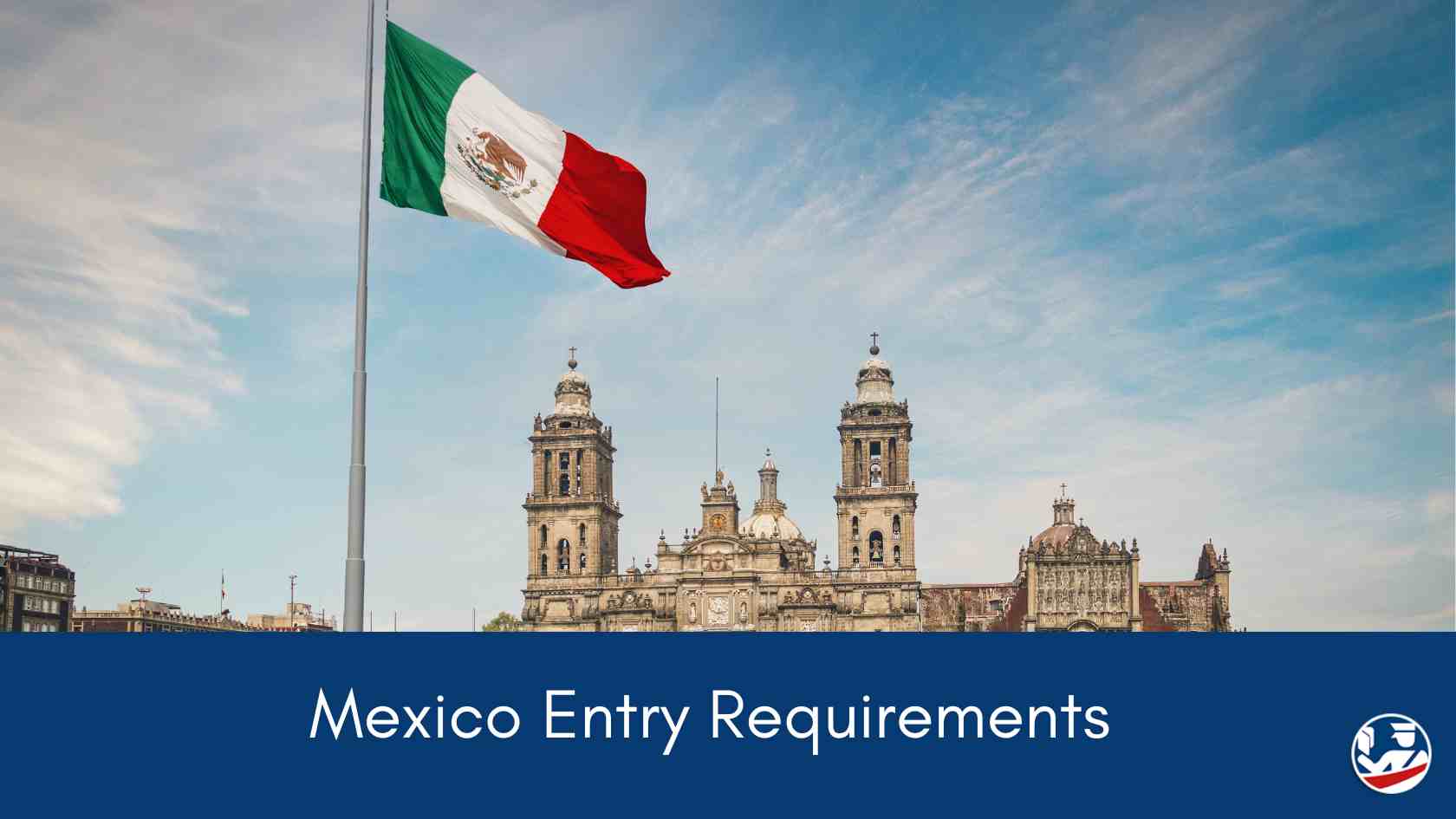
It is one of the most common questions we have received over the past 20 years helping readers like you with their travel document needs:
Do you need a passport to go to Mexico?
The simple answer is yes . US citizens are required to present a valid passport book or passport card when entering Mexico.
There are also some alternative travel documents that can be used in place of a passport depending on where and how you plan to cross the U.S.-Mexico border.
Both the U.S. Department of Homeland Security and Mexican authorities have made a real effort to strengthen border security. As such, there are strict rules about considered a valid travel document to visit Mexico.
The following items are considered valid identification documents for traveling to Mexico:
- A U.S. passport book (required for all international air travel to Mexico)
- A U.S. passport card
- An enhanced driver's license (EDL)
- A trusted traveler program card (NEXUS card SENTRI card, FAST card, or Global Entry card)
- An enhanced tribal card (ETC)
- A military identification card (only for members of the U.S. armed services on official maritime business)
- A Military ID with official orders that require travel to Mexico or through the country's borders
The items listed above are all considered WHTI compliant documents (more on this later). While a passport book is the only acceptable document for international air travel, the rest of these options can be used at most land and sea ports of entry to Mexico and back into the United States.
Note : Not every port of entry has the RFID card readers required to accept any WHTI compliant document other than a passport book. When planning travel to Mexico, travelers should be sure they have the proper type of identification documents accepted by the customs and border protection services at their planned port of entry.
The following documents are not acceptable substitutes for a valid passport:
- a birth certificate
- a standard driver's license
- an automobile registration
- a naturalization certificate
- any other government issued photo ID that is not expressly a WHTI compliant document
While many of these are required documents for getting a passport , none of them are considered a valid travel document on their own for entering Mexico.
Currently, a valid passport book is the best option for all U.S. citizens traveling to Mexico . It is the most reliable and versatile way to travel internationally. If you have a valid passport book, you can be sure it will be accepted at every US Customs and Border Protection (CBP) and Instituto Nacional de Migracion (National Migration Institute) checkpoint.
Regardless of how you plan to travel to Mexico, U.S. citizens who do not have a passport book or a passport card should apply for one well in advance of their trip.
If you are planning a trip to Mexico soon , be sure to consider expedited passport processing options . In some cases, registered passport courier services can help you get a passport in-hand is as few as 24 hours .
Our expert recommendation for passport expediting services goes to Rush My Passport . Their courteous and professional team has offices across the US at the ready to help you get a new passport or renew an existing one quickly and without hassle. With their help, you can save both time and money compared to the costs of getting a rushed passport on your own.
It is worth noting that there are some alternatives to a passport book that will allow US citizens to enter Mexico and reenter the US. However, there are limits to how and where these can be used. For example, none of these alternatives is acceptable for air travel to Mexico or other countries.
Using WHTI Documents to Cross the Mexico Border
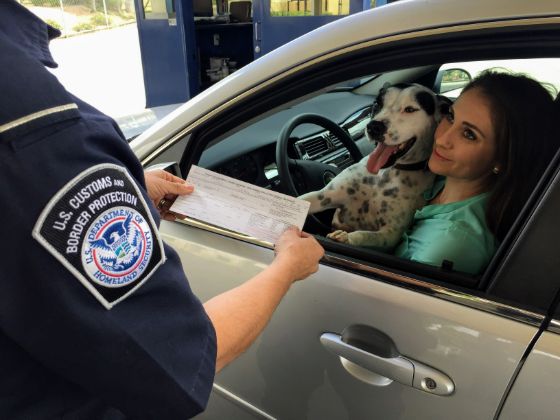
The Western Hemisphere Travel Initiative ( WHTI ) was established in 2007 to both strengthen border security and make it simpler to travel between Mexico, Canada, Bermuda, and some Caribbean Islands. The program is ideal for US, Mexican, and Canadian citizens who must regularly travel back and forth across land or sea border crossings for work, family, or other reasons.
The most common of the WHTI compliant documents is the passport card , but they all essentially work the same way. Presenting one of these documents to Mexican immigration authorities will allow you to enter Mexico by land or by sea.
The same works in reverse. WHTI-approved travel documents meet the entry requirements for US citizens seeking passage back into the United States through most Customs and Border Protection checkpoints.
So, while US citizens must still always present a valid passport or valid identification when crossing back and forth across these borders, the WHTI compliant documents make life more convenient for frequent travelers in a number of ways:
- RFID chips embedded in Western Hemisphere Travel Initiative documents speed up the process of crossing the border by land or sea.
- Passport books have limited number of pages. Without WHTI alternatives, travelers who cross North American land and sea borders often would need to renew passports more frequently. This would cost travelers a lot of time and money.
- Passport books are bulky. Conversely, a passport card, enhanced driver's license, SENTRI card, or other card issued as part of the Trusted Traveler Program can fit in a standard wallet or purse just like any credit or debit card. This makes life easier for those who need to carry travel documents with them as part of their daily routines.
If your international travel plans are focused solely on Western Hemisphere Travel Initiative countries (and don't involve international air travel), this may be a great way to travel to Mexico without a passport book.
Requirements for Minors Traveling to Mexico

Getting a passport for a minor (considered by the State Department to be all U.S. citizens under the age of 16) is the best way to ensure flexibility when traveling to Mexico or any international destination.
For one thing, a passport book is the only way for a child (or anyone) to board and international flight.
This may not seem like a big deal, but should there be an emergency that requires travel abroad, a child will remain grounded without a valid passport book. This goes for traveling to Mexico and back, as well.
There are some acceptable WHTI documents that a minor can be eligible for (a passport card being one), but they carry the same limitations on ports of entry as they do for adults. Chief among them: WHTI documents cannot be used for air travel to Mexico or anywhere else.
In the specific case of traveling to Mexico, there are some other unique circumstances carved out for minors without passports:
- Children who are U.S. citizens and under age 16 arriving by land or sea from contiguous territory can travel to Mexico from the United States without a passport. They must present an original or copy of his or her birth certificate, a Consular Report of Birth Abroad, a Naturalization Certificate, or a Canadian Citizenship Card when entering Mexico and when returning to the United States.
- Children under the age of 19 who are U.S. citizens traveling with a school group, religious group, social or cultural organization or sports team , may present these documents as well; however, they must also provide documentation from the supervising organization, contact information, and letters of consent from a legal parent or guardian.
In either case, a passport book is still the most convenient option to ensure maximum travel flexibility.
Tourist Travel

A visa or tourist card - also called a Forma Migratoria Multiple (FMM) is now required for all U.S. citizens visiting as tourist for six months. Previous exemptions for short stays (less than 72-hours) or stays within the border zone no longer apply.
This Mexican tourist card is mandatory for all leisure visits by land, sea, or air. These FMM cards serve as your entry permit and can be purchased at Mexican consulates, Mexican border crossings, tourism offices, airports, and airline offices.
Mexican immigration officers and other law enforcement entities have the right ask visitors to provide proof of their legal status at any time. As such, travelers are expected to keep their tourist cards with them at all times.
Any non-Mexican citizen must must present a valid form of travel documentation-as well as their Mexican tourist card-upon request.
It is worth noting that, on occasion, travelers that have been unable to produce proper documentation have been detained by Mexican officials. Border protection and security is a big deal across North America, not just in the United States. For this reason, it is a good idea to keep photocopies of your passport and tourist card in case the originals are damaged, lost , or stolen .
While these tourist cards remain valid for up to 180 days, U.S. citizens must return the cards when they depart Mexico. Visitors who are unable to present their card may encounter significant delays and be asked to file a police report, pay fines, and/or go through the process of obtaining an exit visa .
Do You Need a Passport for Closed Loop Cruises?
No. Even if you don't have a valid passport yet, it is possible to visit Mexico as part of a closed loop cruise. You must present a valid form of identification to board, but you do not need to have a valid passport book or passport card.
Closed loop cruises are unique travel itineraries in which a cruise line starts and ends its journey from a port within the United States.
While these cruises may travel through waters controlled by other countries (or even dock at a foreign port of entry), the US citizens on board are not required to have a valid passport. Travelers can board and remain on the cruise with whatever valid identification documents the cruise line accepts.
This is a great way to travel without a passport , but it can also be quite limiting. A cruise line may advertise particular voyages as a closed loop cruises, but still offer excursions on land for travelers with valid passports or WHTI compliant documents that meet the entry requirements of the port. Being able to present a valid passport opens up the maximum potential for making the most of a cruise to Mexico - closed loop or otherwise.
Business Travel

Travelers visiting Mexico for business must also complete and submit Form FFM . This form authorizes visitors to conduct business, but not to obtain employment. Business travelers, other non-tourist travelers, or any visitors remaining for more than 180 days must have a Mexican visa and a valid passport to enter the country. U.S. citizens can apply for a Mexican visa at the Mexican Embassy or any Mexican consulate .
For travelers expecting to cross the U.S.-Mexico border on a regular basis, the SENTRI card issued by the U.S. Customs and Border Protection (CBP) may be worth acquiring. It allows access to speedy commuter lanes, drastically reducing time spent waiting in line at CBP checkpoints.
Similarly, the FAST card allows commercial drivers (typically trucks) access to dedicated lanes through most North American border crossings.

Any U.S. vehicle traveling beyond the Mexican border zone may be confiscated unless the driver is able to present a temporary import permit (TIP). Incarceration, fines, or vehicle seizure may result from driving into the Mexican interior without this documentation.
Obtaining this permit involves producing several required documents:
- evidence of citizenship
- a vehicle title
- a valid vehicle registration
- a valid driver's license
There is a processing fee, as well.
In addition to the items listed above, drivers must also post a bond at an office of the Banjercito (the Mexican Army Bank) to guarantee that the vehicle will be exported by a certain date. This monetary deposit can be made by cash or credit card.
Posting this bond at a Mexican customs office or certain Mexican consulates will allow you to avoid additional fees and charges. You will receive a refund of your deposit as long as you leave Mexico before your Forma Migratoria Multiple (FMM) entry permit expires.
Be warned , travelers should never accept the service of individuals outside of official permit offices or consular agencies offering expedited service. These services are largely fraudulent and lack the authority to accept deposits, issue proper documentation, or handle deposit refunds.
Vehicles traveling in the Baja Peninsula or vehicles with the "Only Sonora" program are exempt from this requirement. This program allows any vehicle that enters at a land border in the Sonoran region to travel without a permit as long as it does not leave the region.
What may be brought into Mexico
U.S. citizens must declare the value of any gifts they are carrying when they enter Mexico.
There is a $75.00 duty free limit for entry by land, and a $300.00 limit for entry by air.
Alcohol and tobacco products always incur a duty. Personal effects will not incur a duty unless they exceed certain limits specified by Mexican customs. Undeclared items may be seized by customs.
Regulations are in place regarding imports, exports, and property donations, and visitors should contact the Embassy of Mexico or a Mexican consulate if they need details.
Before packing, consult our guide of the items NOT to pack for an international trip .
Dual Citizenship
Dual U.S./Mexican nationals should carry citizenship documentation for both countries when traveling to Mexico. In the case of Mexico, this means carrying both a U.S. and Mexican passport.
Mexico considers U.S. citizens born in Mexico or to Mexican parents to be dual citizens of Mexico. Dual citizens may be required to complete a period of military service in Mexico, and may have difficulty receiving U.S. consular assistance in the event of arrest or other emergencies. Dual nationals must declare their U.S. citizenship when returning to the United States.
The Border Zones
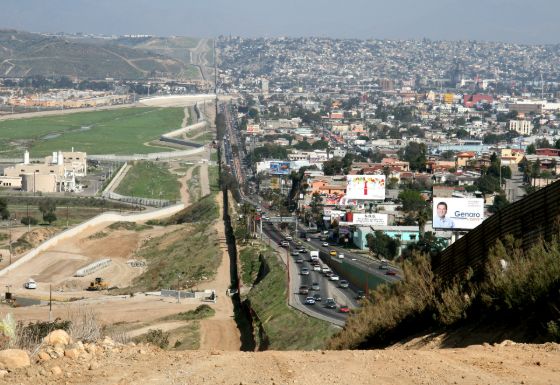
The immediate border area between Mexico's northern sates and the southern United States is known by many names:
- The Border Zone
- The Free Zone
- The Free Trade Zone
- The Liberated Zone
- The Hassle-Free Zone
- The Perimeter Zone
Initially, this area stretching 12-20 miles across the Mexican border, was designed to encourage travel and trade between Mexico and US travelers. As such, there were no FMM entry permit or Temporary Vehicle Import Permit (TIP) requirements. Passports were still a necessity, though.
This changed in 2015. The Mexican government required all those traveling to Mexico to get an FMM permit to enter the county. As it stands now, the only benefit to the Border Zone area is that a TIP is not required for vehicles that are not registered with Mexican documentation. Passports (or WHTI equivalents) and FMM are now always required for US citizens entering Mexico.
Still have questions about the requirements for crossing the U.S.-Mexico border? The Bureau of Consular Affairs website is the best source for further information about current regulations.
Should you need to obtain travel documentation quickly, be sure to visit our guides on how to expedite your passport and visa applications .
Top 5 Questions About Expedited Passport Couriers
1. How can you get a passport when you're in a hurry? 2. What exactly does a passport expediter do? 3. Are passport expediting services legitimate? 4. How can I identify a reliable passport expeditor? 5. Is expedited passport service worth it?

Get the Latest Updates
You can also search using these:
Discover Mexico A-Z

- News & Offers
- Mexico Guides
- Mexico Features
- Free eBooks
- Free Guides
Travel Experiences
Trip planning, travel destinations, destination highlights, mexico lifestyles, living & lifestyle, lifestyle planning, real estate, healthcare & wellbeing, leisure assistance, lifestyle assistance, insurance coverages, property assistance, about mexperience, mexico essentials, discover more, mexico entry requirements—for leisure, business or residency.
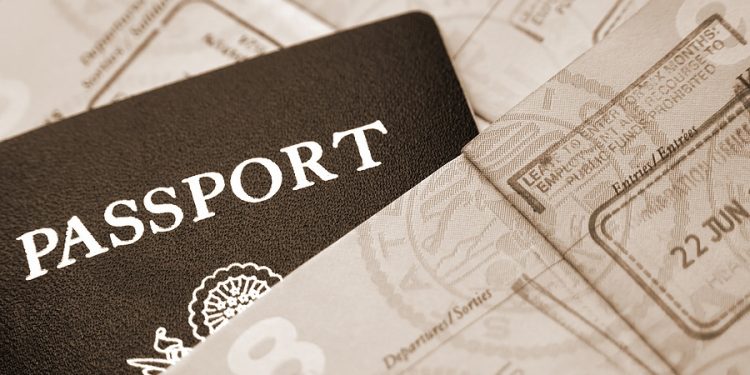
This guide explains what you need to know about entry requirements when you are visiting Mexico for leisure, for business, or to take up residency here.
Mexico entry requirements for tourists and short term visitors
Mexico visitors permit, fmm.
Passport holders from countries on Mexico’s no visa required list do not need to apply for a formal visa to visit Mexico. They may, instead, use a visitor’s permit, known as a FMM ( Forma Migratoria Multiple ).
For the countries that don’t need a visa , a Mexico Visitor’s Permit (FMM) is issued in place of a visa. Learn more about Mexico’s visitor permit, the FMM .
How long is your Mexico visitor permit valid?
When you enter Mexico as tourist or business visitor, the immigration official at the port of entry will grant you a number of days stay in Mexico and write this on your visitor permit. This will be a maximum of 180 days; but it may be less than 180 days.
Check to see how many days you are granted to determine your exit date.
Learn more about the number of days being granted to people arriving in Mexico under the auspice of a visitor permit, FMM.
Visitor permits cannot be extended or renewed
The Visitor Permit (FMM) will always expire after the number of days written on the permit: it cannot be extended beyond the number of days the immigration official grants when you arrive in Mexico, even if this is less than the maximum allowance of 180 days; and cannot be renewed. You must leave the country before it expires.
Your Mexico Visitor Permit, FMM
Do I Need A Visa to Visit Mexico
Entry to Mexico: Essential Information for All Travelers
Regardless of whether you come to Mexico for leisure, for business or to take up residency here, take note of the following:
Required documentation
For a summary of the documentation required to enter Mexico, see Documents required for travel and entry to Mexico
Minors traveling to Mexico alone
Minors traveling to Mexico alone, or unaccompanied by at least one parent or their legal guardian: Read Traveling with Minors to Mexico .
Passport validity
The maximum period of time that a visitor/tourist may stay in Mexico under the auspice of a visitor permit (FMM, see above) is six months.
Therefore we recommend that your passport, regardless of country of origin, should be valid for a minimum period of six months, however long you intend to stay to avoid any potential problems at the port of entry.
Immigration authorities at the port of entry may allow or deny entry of any person into Mexico. If you have a passport that is valid for less than six months and you intend to stay in Mexico for a short period of time —perhaps a vacation— the Immigration Officer might allow you entry, especially if you can show a return air ticket.
Notwithstanding this, we recommend that you and your family members hold passports valid for at least six months from the date you intend to enter Mexico.
For holders of U.S. Passport Cards
U.S. passport cards are less expensive than passport books and can be used by U.S. citizens who cross the border between the United States and Mexico by land or sea. These look like a driver’s license, and are more robust and less bulky than a passport book. You can learn more about Passport Cards on this page of the US State Department web site. If you are a holder of a U.S. Passport Card, please note that this is NOT valid for air travel to Mexico . Passport Cards can only be used to cross the border between the United States and Mexico by land or sea ports. A passport is required for air travel to and from the the United States.
Traveling to Mexico via the United States:
In January 2009 the United States government introduced new rules for travelers entering the country using the Visa Waiver Program (US State Dept). See Also: Travel to Mexico via the USA
Arriving to Mexico by cruise ship
If you are traveling on a cruise ship that visits Mexico, you will be asked to complete a Visitors Permit/FMM (see information above) at your first Mexican port-of-call. This permit will be valid for a maximum of 21 days. Ask your cruise company for details.
Traveling in transit through Mexico
As of February 2004 foreigners passing through one of Mexico’s international airports to a third country no longer require a visa or any migratory documentation, provided that they remain at the airport and depart Mexico within 24 hours of arrival. See Also: Entry Procedure at Mexican Ports
Entry requirements for business visits to Mexico
Mexico welcomes business visitors and makes the immigration procedure for short visits straightforward by means of a special section on the Visitor’s Permit described above.
Business visits to Mexico
If you are traveling on business, or representing a company to conduct business in Mexico, and you hold a passport from a country on Mexico’s “ no visa required list ” you do not need to apply for a formal visa to visit Mexico. You can, instead, use a visitor’s permit —the same entry permit and procedures used by tourists to enter Mexico (see section above for full details).
If the country you hold a passport for does not appear on the no-visa list , you should check with your nearest local Mexican Consulate for details of visa requirements before you travel to Mexico.
Longer-term business visits to Mexico
If you plan to work or live in Mexico longer periods ( more than 180 days ), you will need to apply for a business visit visa.
This visa enables the visitor to live, work and do business in Mexico, provided that certain criteria are satisfied. You can get more detailed information about long-term living and working permits on Mexperience by connecting to the Immigration Page that contains lots of information and advice about living and working in Mexico. See also: Working in Mexico
Entry requirements for residency in Mexico
People wishing to travel to Mexico to live, work, or retire must meet certain criteria to do so. Mexperience has comprehensive sections of information dedicated to these topics of interest:
Residency visas and immigration
Our guide to Mexico Visas and Immigration page gives an overview of the requirements for temporary and permanent residency in Mexico. Also see the regularly-updated Mexico Immigration FAQs page for the most-commonly asked questions about immigration to Mexico.
Entry Procedure at Mexican Ports
The entry procedure will vary depending on where you arrive in Mexico and whether you arrive as a visitor or as resident. See also: Procedures for Entering and Leaving Mexico
Mexican Customs procedures and allowances
Like all countries, Mexico has policies on what can be brought in to the country without paying duties or taxes.
Your customs allowances when entering Mexico
Allowances are subject to change without notice, but listed below are the principal items followed by some tips about entry to Mexico.
- Personal Luggage: including new and used goods for personal use to include clothes, footwear, personal hygiene and beauty items which, according to the form: ‘reasonably respond to the duration of the trip and that due to its quantities may not be used for commercial purposes’;
- Two photographic or video cameras and twelve rolls of film or videotapes;
- Two mobile phones or pagers;
- One used or new laptop; one used or new printer; one projector;
- Two used or new items of sports gear;
- One CD player or portable music player; one DVD player;
- One musical instrument;
- Three surfboards; four fishing rods; a pair of skis;
- Ten packs of cigarettes (200 cigarettes total), twenty-five cigars OR 200 grams of tobacco (over 18s only);
- Vaping imports banned: The commercial import of vaping products was banned in February 2020; however, small quantities for personal use by visitors to the country should not be confiscated (vaping itself is not illegal in Mexico); bringing an ‘excess’ deemed reasonable for personal use may cause your entire supply to be confiscated.
- Three liters of liquor AND six liters of wine (if the person is aged over 18 years);
- There is a US$300 tax exemption on items you import (in addition to those already listed above) when you enter the country by means or air or maritime transport; the exemption is reduced to US$50 if you travel in by land, except at Easter, Summer Holidays and Christmas time, when the land exemption limit is increased to US$300.
Please Note: Refer to the Mexican Customs web site for full details about customs allowances as these limits are subject to change with little or no notice .
MEXICAN CUSTOMS: TIPS & ADVICE FOR TRAVELERS
Bringing prescription drugs to Mexico: You are allowed to bring prescription drugs into Mexico provided that you have the accompanying documentation which proves a medical need. If you or a member of your family are taking prescription drugs, be sure to take the prescription/doctor’s note with you, which includes the patient’s name and the name of the medication(s) to prove medical need of the drugs you are carrying in case your luggage gets inspected.
Don’t bring firearms or ammunition! A foreign firearms license is not valid in Mexico ; if you own a gun, don’t take it to Mexico with you and don’t bring any ammunition with you either. The only exception is a firearm and ammunition used for hunting purposes; but you will need to apply for a special permit – contact your local Mexican Consulate . Being in possession of lethal knives, firearms of all types, and even a single round of ammunition is a Federal crime in Mexico: caught in possession of a firearm can land you in very serious trouble—even if you have a license for it that was issued in your home country. See Also: Mexico’s Strict Gun Laws
Type and quantity of items : Don’t bring anything that obviously looks like you’re planning to resell goods; for example, several laptop computers. These items will get heavily taxed or confiscated. Items for personal use will be allowed, new or used, but only in quantities that are commensurate with the definition of ‘personal use.’ If you are carrying large quantities of anything, or if the Customs Inspector believes you are trying to commercialize any of the goods you are carrying, then you may be interviewed further.
Drug smuggling: Every year, foreign nationals are arrested and convicted for drug smuggling in Mexico. Don’t attempt to smuggle any narcotics – not even small amounts of ‘soft’ drugs, e.g. cannabis/marijuana. You may be required to present documentary evidence for any powerful prescription drugs you need to carry on your person (i.e. doctor’s prescription, see note above about prescription drugs.) Narcotic offenses (use of, import, export, dealing) are likely to land you in a Mexican prison for many years. Don’t expect your consulate to bail you out because it won’t be able to. 20-25 year prison sentences for drug and serious firearm-related offenses are not uncommon in Mexico.
What you may take home from Mexico
Customs allowances into your home country will depend on where you live.
If you are planning to do a lot of shopping in Mexico, you should check at the information desk at (air)port of departure in your home country for the latest duty-free allowances.
Most goods classed as art and craft work are free of import taxes and you can bring as many home as many as you like, provided the quantities would be considered ‘for personal enjoyment’. Check with your local port/customs authorities for details.
The following items are are typical of duty-free allowances in many countries:
- 200 Cigarettes;
- 50 Cigars or 250g of Tobacco;
- 2 liters of wine;
- 1 or 2 liters of liquor (depending on country);
- 60cl of perfume;
- In addition to the above: a US dollar or euro amount of goods, ranging from about US$300-$500, depending upon the country. If you go over the monetary limit, duty and tax is usually payable on the whole amount not just the sum above the limit;
- Exact rates and amounts vary by country/trading block. Check with the information desk at your home country’s port of departure for the latest details on allowances
Leaving Mexico and Consular Contacts
Leaving mexico.
There are some procedures to follow when you depart Mexico, whether you are a visitor, or resident here:
If you are in Mexico as a tourist/visitor: When you leave Mexico, you will need to show your visitor permit you were issued with when you arrived. See also: Your Mexico Visitors Permit, FMM
If you are resident in Mexico be sure to the immigration desk at the airport or land border to show your residency card and get passport stamped before you leave the country . See also: Procedures for entering and leaving Mexico
Foreign Embassies and Consulates
Foreign nationals may be able to get assistance from their country’s consulate. Read our article about seeking consular assistance in Mexico for further details.
Directory of Mexican Consulates Abroad
Directory of Foreign Consulates in Mexico
Mexico in your inbox
Our free newsletter about Mexico brings you a monthly round-up of recently published stories and opportunities, as well as gems from our archives.
Visa for Mexico

Do I Need a Visa to Visit Mexico?
Do you need a visa to visit Mexico? This article explains who —and who does not— need to apply...
FAQs Visitor Permit

FAQs: Mexico’s Visitor Visas and Visitor Permit, the FMM
These are the most frequently-asked questions we receive in relation to Mexico's visitor visas, and the visitor permit—updated regularly
Time Limits

Time Limits on Mexico Visitor Visas and Residency Permits
Discover answers to common questions about time limits as well as exit/entry rules for Mexico visitor visas and residency...
Documentation

Documents Required for Travel and Entry to Mexico
A reminder about the documentation that is required for travel and entry to Mexico whether you are visiting or...
Entry & Exit

Procedures for Entering and Leaving Mexico
There are some straightforward paperwork procedures to engage with when you arrive to, and depart from, Mexico. This...
Volunteering in Mexico

This article explains what you need to know about visas if you plan to undertake some volunteer work in...
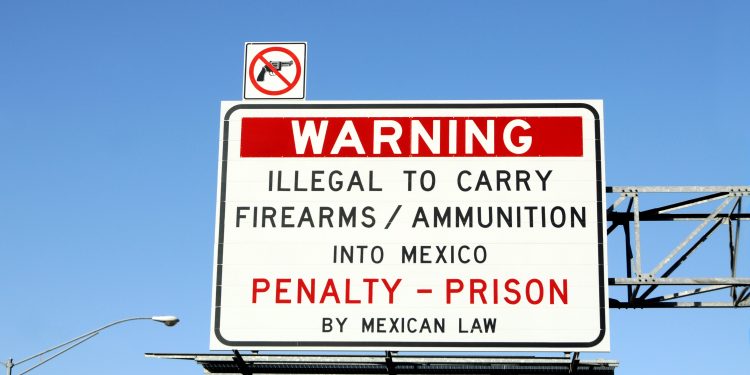
Mexico’s Strict Gun Laws
Mexico’s gun laws are similar to those in countries like the United Kingdom that do not allow possession of...
Routes to Residency

Principal Routes to Obtaining Legal Residency in Mexico
This article describes principal routes foreigners take to apply for legal residency in Mexico, with references to additional information...
Immigration Assistance
Mexico immigration assistance.
Our associates provide advice to apply for residency in Mexico and practical assistance as you make your way through...
Consular Assistance
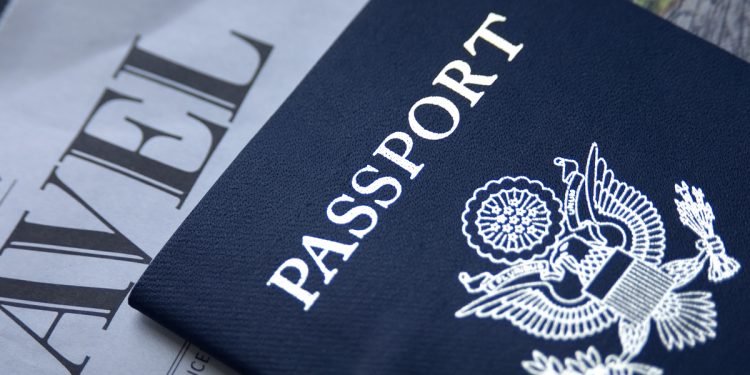
Obtaining Assistance from Your Country’s Consulate in Mexico
Foreign Consulates in Mexico provide a range of support services to their citizens, but there are limitations to the...
Mexican Consulates

Directory and details of Mexican Consulates situated around the world
- Search Please fill out this field.
- Newsletters
- Destinations
- More to Explore
Before You Travel to Mexico
M Swiet Productions / Getty Images
Are you looking to plan your first trip to Mexico? There are several different aspects to consider before you go, from travel documents to health and safety concerns, and of course which destination to choose and what activities to pursue during your stay. Here are some resources to help you get your trip planned and figure out what you need, where you should go and what you should do, to help make your Mexico vacation a success.
General Info
Having some basic knowledge about Mexico before you go will help you make the most of your time there.
- Weather in Mexico
- Spanish Phrases
Your first consideration should be the timing of your trip. Your own schedule may be the determining factor, but you will want to take into account the weather in Mexico, any festivals or events that you'd like to attend, and whether it's high or low season.
- The Best Time to Visit Mexico
- Mexico Month-By-Month
Where to Go and What to Do
Choosing your destination and activities, and planning your itinerary can be one of the most fun aspects of preparing for your trip. The options are limitless. Do you want to get a tan on one of Mexico's gorgeous beaches , learn about history in one of its fascinating colonial cities , or let the good times roll at one of the country's vibrant fiestas?
- Top Destinations in Mexico
- One Week Itineraries
Passports, Travel Documents and Entry Requirements
Early in your travel planning, you should make sure you have all the necessary documents to travel to Mexico. Passports can take a few months to process so make sure you apply far enough in advance. You probably won't need to apply in advance for a visa: when you enter the country you will be given a tourist card.
- Passports and Travel Documents
- Tourist Cards for Mexico Travel
- Entry Requirements for Children
Money Matters
Find out how to manage your cash in Mexico, what you need to know about carrying money, exchange rates for the Mexican peso and other concerns about money for travel in Mexico.
- Mexican Money
- Mexico Tipping Guide
- Exchanging Currency in Mexico
- Exchanging Dollars to Pesos
- Tourist Tax Refunds
Mexico Travel Health Issues
Staying healthy is an essential factor in making sure you enjoy your time in Mexico. The main health problem that visitors to Mexico face is the dreaded Montezuma's Revenge, which is really just a fancy way to say traveler's diarrhea. There are some pretty simple precautions you can take to avoid having this problem, though.
- Avoiding Montezuma's Revenge
- Dengue Fever in Mexico
- Zika Virus in Mexico
Staying Safe in Mexico
There's been a lot of brouhaha recently about safety in Mexico and a lot of people are worried that Mexico is too dangerous, but most of Mexico remains safe to visit. You can improve your chances of staying safe while traveling in Mexico by following thse tips.
- Travel Safety Tips
- Spring Break Safety
Getting Around Mexico
If you're planning a short getaway you may just go to one destination and stay there the whole time, but if you have a bit more time and are hoping to see more of Mexico, you'll have to deal with transportation. Getting around Mexico can be a challenge, but it's worth it to experience more of what the country has to offer.
- Transportation Options in Mexico
- Bus Travel in Mexico
- Air Travel in Mexico
- Driving in Mexico
- Taking Authorized Taxis
Related Articles
More related articles.

Do You Need a Passport to Go to Mexico?
Everything you need to know about travel requirements to visit the united states’ southern neighbor..
- Copy Link copied

What documents are necessary to visit Mexico’s wondrous destinations?
Photo by Shutterstock
With colorful fiestas, lively cities, dense jungles, some of the world’s greatest archaeological monuments, and roughly 7,000 miles of coastline prime for sunning and snorkeling, Mexico is a popular destination for U.S. travelers. And if you’re eyeing a trip across the southern border, you might be wondering what the travel requirements are, particularly whether a passport is necessary or if an alternative document is available. Here’s what you need to know.
Do you need a passport to enter Mexico?
Yes, Americans need a passport (or appropriate alternative travel document) to visit Mexico.
In the past, visiting Mexico with just a driver’s license or birth certificate was possible. However, in 2009, the U.S. Department of State implemented the Western Hemisphere Travel Initiative (WHTI), which requires all U.S. citizens and legal residents to present a valid passport when entering or re-entering the United States from Mexico by land, sea, or air. The initiative was made “ to strengthen border security and facilitate entry into the United States. ” It made passports the standard document for travel between the United States, Canada, Mexico, the Caribbean, and Bermuda.
Acceptable alternative documents for crossing the U.S.-Mexico border
If you’re a U.S. citizen without a traditional passport, you can use a few other documents to visit Mexico.
Passport card
The U.S. government introduced the passport card as a convenient and cheaper alternative to the traditional passport book; it is good for land and sea travel to Mexico, Canada, and the Caribbean. The passport card is wallet-size (much like a driver’s license) and includes information about its owner, including full name, nationality, place of birth, gender, dates of issue and expiration, a unique ID number, and photo.
Passport cards, however, are only accepted for land and sea travel between the U.S. and Mexico. Air travel to Mexico still requires a passport book.
SENTRI pass
There’s also the SENTRI (Secure Electronic Network for Travelers Rapid Inspection) pass, which is a trusted traveler program similar to Global Entry or TSA PreCheck .
The program requires prescreening and provides participants with a special card that can be used in place of a passport for land border crossings (by car or foot). While primarily aimed at frequent cross-border travelers, these programs offer a convenient option for those looking for efficient travel between the two countries.
Enhanced Driver’s Licenses
A handful of U.S. states offer Enhanced Driver’s Licenses , which contain additional security features that allow them to be used in lieu of a passport for travel to Mexico by car. Enhanced Driver’s Licenses are available in Michigan, Minnesota, New York, Vermont, and Washington.
Do you need a passport on a cruise that stops in Mexico?
Americans can also travel to Mexico (and certain other Caribbean islands) without a passport if they’re on a “closed-loop” cruise .
Basically, a closed-loop cruise leaves from and returns to the same U.S. port for embarkation and disembarkation. The rules for sea travel were established under the Western Hemisphere Travel Initiative and allow Americans to travel to Bermuda, the Bahamas, and Mexico without a passport, specifically on closed-loop sailings. However, some cruise companies require (or at least recommend) that you have a passport in case of emergency (such as a medical issue that causes you to fly home early).


- Immigration
Essential Documents for Traveling to Mexico: A Complete List
If you're planning to travel to mexico, it's important to have the necessary documents with you. this list will help you ensure a smooth journey, including a valid passport, tourist visa (if applicable), and any additional documents required by mexican immigration authorities. stay prepared and organized for your trip to mexico with these essential documents..

Key Takeaways:
- To travel to Mexico , you’ll need a valid passport or passport card, a tourist card, and possibly a visa or residency permit.
- It’s recommended to have travel insurance and necessary driving documents if planning to drive in Mexico.
- Minors traveling without both parents should have a notarized letter of permission, and carrying copies of important documents is advisable.
Essential Documents for Traveling to Mexico
Are you planning a trip to Mexico? Whether you’re visiting for a vacation or for business, you need to be well-prepared with the right documents to ensure a hassle-free experience at the border. Here’s a handy list of essential documents that you should carry with you when traveling to Mexico.
- Valid Passport or Passport Card
Your passport is the most critical travel document for international travel . Ensure that your passport is valid for the duration of your stay. If you’re traveling by land or sea, you can also use a passport card, but this is not valid for air travel.
Tourist Card (FMM)
When visiting Mexico for tourism, you’ll need a Tourist Card, also known as Forma Migratoria Múltiple (FMM). You can obtain an FMM upon arrival or online. It’s valid for up to 180 days and is a requirement for tourists entering Mexico.
Visas and Residency Permits

Depending on your country of origin, you may need a visa to enter Mexico. Check the specific requirements for your nationality before your trip. For long-term stays or other specific situations, such as work, you may need to apply for a residency permit.
Also of Interest:
Applying for a permanent residence card as an eu citizen in the uk, steps to take if your f1 visa is denied: appeal or explore student visa alternatives, travel insurance.
While not a mandatory document, it’s wise to have travel insurance that covers health emergencies, accidents, and trip cancellations. This can save you from unexpected expenses and give you peace of mind.
Driving in Mexico
If you’re planning to drive in Mexico, bring your driver’s license and consider obtaining an International Driving Permit. Moreover, proof of car insurance is essential, as U.S. auto policies are usually not valid in Mexico.
Additional Documents for Minors
For children traveling without both parents, a notarized letter of permission from the absent parent(s) is recommended. This helps prevent issues at immigration checkpoints.
Copies of All Important Documents
It’s always a good idea to carry copies of all your travel documents. In case you lose any originals, copies can be helpful when arranging replacements.
For the most current information on document requirements and immigration procedures, be sure to visit the Mexican consulate’s website or the U.S. Department of State’s travel page for Mexico .
Remember, laws and policies can change, so check for any updates before your departure. Preparing the right paperwork might seem like a chore, but it’s essential for a smooth journey. With these documents in hand, you’ll be all set to enjoy all that Mexico has to offer!
It is essential to verify the entry requirements concerning the ongoing global health situation, as additional documents such as health declarations or proof of vaccination may be required. Keep an eye on travel advisories and guidelines from both your home country and the Mexican authorities to stay informed about any changes.
Embarking on an international trip should be an exciting experience, not a stressful one. By ensuring that your document checklist is complete, you’ll be able to focus on the important part – making the most of your time in Mexico.
So, there you have it, my amigo! The lowdown on essential documents for Mexico travel. Don’t stress about documents during your trip, just prepare ahead and enjoy the fun! And hey, if you want even more travel tips, be sure to check out visaverge.com. Happy exploring!
FAQ’s to know:
FAQ 1: What are the essential documents needed for traveling to Mexico?
To travel to Mexico, you will need the following essential documents:
- Tourist Card (FMM) for tourism purposes
- Visa (if applicable)
- Residency Permit (if applicable)
- Travel Insurance (recommended)
- Driver’s License (if driving in Mexico)
- International Driving Permit (recommended for driving)
- Proof of Car Insurance (if driving in Mexico)
- Notarized Letter of Permission for minors traveling without both parents
- Copies of all important documents
These documents are necessary to ensure a hassle-free experience at the border and during your stay in Mexico.
FAQ 2: Where can I obtain a Tourist Card (FMM) for traveling to Mexico?
You can obtain a Tourist Card, also known as Forma Migratoria Múltiple (FMM), when visiting Mexico for tourism purposes. You have two options:
- Obtain the FMM upon arrival in Mexico: When you arrive at the Mexican border, you can get the FMM from the immigration officials. Fill out the required forms accurately and keep the FMM with you until your departure from Mexico.
- Obtain the FMM online: Alternatively, you can pre-fill and print the FMM before your trip to expedite the process. Visit the official Mexican government website or the Mexican consulate’s website to access the online application.
Remember, the FMM is valid for up to 180 days and is a requirement for tourists entering Mexico.
FAQ 3: Do I need travel insurance when visiting Mexico?
While travel insurance is not a mandatory document for visiting Mexico, it is highly recommended. Travel insurance provides coverage for health emergencies, accidents, and trip cancellations, saving you from unexpected expenses and giving you peace of mind during your trip. It’s always better to be prepared for unforeseen circumstances, especially when traveling abroad. Ensure that your travel insurance covers the specific needs of your trip to Mexico and verify the coverage details before your departure.
What did you learn? Answer below to know:
- True/False: A Tourist Card, also known as Forma Migratoria Múltiple (FMM), is required for all travelers entering Mexico.
- What additional document is recommended for minors traveling to Mexico without both parents?
- What essential document is required for driving in Mexico, especially if you hold a U.S. driver’s license?
Verging Today

New USCIS Rules for H-1B Workers After Layoffs
USCIS issues guidelines for H-1B layoffs impacting immigrant workers at companies like Google and Walmart. Stay informed on visa terminations.
Trending Today
U.s. visa invitation letter guide with sample letters.
Learn how to write an invitation letter for a U.S.…
What is “Approval Case Decision Rendered” Status Mean for Form I-129? Explained
Approval Case Decision Rendered status on Form I-129 indicates USCIS…
Understanding the B1/B2 Visa 6 Month Rule: Stay Duration Explained for Multiple Entries
Learn about the B1/B2 visa 6 month rule and understand…
USCIS Letter Sample: Guide to Writing letter to USCIS
Learn how to write a letter to USCIS and what…
Renew Indian Passport in USA: Step-by-Step Guide
Looking to renew your Indian passport in the USA? This…
How to Fill Form I-589: Asylum Application Guide
Form I-589 is for asylum seekers in the U.S., granting…
Green Card Backlog for Indians: Current Wait Times in 2024
The backlog for Indian employment-based green cards in the U.S.…
2024 UK Visa Update: Remote Work Rules for Visitors | Digital Nomad Visas Explained
UK Immigration unveils Remote Work Perks, differing from Digital Nomad…
Bringing Prescription Medications to the UK: Requirements and Regulations
When bringing prescription medications to the UK, it is important…
F1 Visa Student Tax Guide: Understanding OPT Taxes
Participating in Optional Practical Training (OPT) can have tax implications…
Sign in to your account
Remember me
Mexico Entry Requirements for U.S. Citizens
Mexico Visa Needed
(for stays of up to 180 days)
Tourist Card (FMM) Needed
(if traveling by land)
Mexico has a number of entry requirements that citizens of the United States must meet when visiting the country.
US citizens planning to travel to Mexico should first check if they require a visa to cross the border, according to the Mexican visa policy.

What U.S. Citizens Need to Travel to Mexico
American citizens must have a few essential documents to travel to Mexico. These include:
- US passport
- FMM tourist card (for land travel)
- Mexican visa (if applicable)
A visa for Mexico may not be required for US passport holders. This depends on the period of stay and your reason for traveling.
U.S. passport requirements for Mexico
Your US passport must meet certain criteria when traveling to Mexico. It must not expire for at least 6 months after the date of arrival.
If your passport is due to expire sooner than this, renew it before getting the FMM and traveling to Mexico.
Do U.S. citizens need a Tourist Card for Mexico?
Americans must register for a Mexico tourist card to visit the country for the following reasons:
The tourist card required by visitors from the US is called the Forma Migratoria Múltiple (FMM) .
The FMM is not a visa. It’s an entry requirement for all foreign visitors, including Americans . It’s mandatory if you plan to travel more than 20 kilometers into Mexican territory and stay more than 72 hours.
A Mexican tourist card for United States citizens is a single-entry document. It becomes invalid once you leave Mexico. You need to get a new FMM for every trip to the country.
Do U.S. citizens need a Mexican visa?
Tourists and business travelers from the United States can stay up to 180 days visa-free in Mexico. Americans can also transit in Mexico for up to 30 days without a visa.
The same is true for non-US nationals who hold a valid US visa or Green Card . These documents must be brought as proof to gain visa-free entry to Mexico.
Citizens of the United States who plan to work, study, or engage in other non-tourist or business activities need a visa for Mexico .
Americans also need a visa to stay in Mexico for more than 180 days.
How Can U.S. Citizens Apply for a Mexico Tourist Card?
US citizens can now complete the tourist card form online. This saves time and the inconvenience of dealing with paperwork during their journey or at border control.
The streamlined electronic form greatly expedites the process of entering Mexico .
Mexico's Immigration Policy for U.S. Nationals
Citizens of the United States of America must comply with Mexico’s immigration policy when traveling to the country.
US nationals must :
- Have the correct documentation
- Comply with customs and border regulations
- Leave Mexico within the time permitted (180 days for visa-free visitors)
Americans must not :
- Bring any unauthorized or illegal items into Mexico
- Overstay the terms of their visa or visa exemption
Do Americans need vaccinations for Mexico?
Mexico’s travel rules for US passport holders do not include any mandatory vaccinations .
However, the US CDC highly recommends being immunized against the following before traveling to Mexico:
- Hepatitis A and B
Malaria is present in certain areas of Mexico. US nationals are advised to bring anti-malaria medication if staying in these regions.
What Do U.S. Citizens Need to Leave Mexico?
When leaving Mexico , you’re required to present the tourist card alongside your passport.
Therefore, it’s important to keep the slip of paper safe during the entirety of the stay in the country.
The validity of the FMM document for Americans begins from the moment it is stamped at the Mexican border . If the FMM is lost or stolen before arriving at immigration control in Mexico, you can obtain another form online.
If a validated Mexico FMM for US citizens is lost or stolen within Mexico, you should report the theft to local police. You must then include the subsequent police report in the application for a replacement tourist card. You can do this at an Instituto Nacional de Migración office within Mexico.
The U.S. Embassy in Mexico
The US Embassy in Mexico is located in Colonia Cuauhtemoc, Mexico City. The embassy provides a variety of services to American citizens in Mexico.
These include emergency assistance in cases of:
- Loss of passport
- Arrest of a US Citizen
- Death of a US Citizen
- International Parental Child Abduction
The embassy can provide emergency financial assistance and support to US citizens who are victims of crime. It is also authorized to issue certifications of US citizenship for eligible individuals born abroad to American parents, among other services.
Register with the U.S. Embassy in Mexico
It is now possible for US citizens and nationals to register with the nearest embassy or consulate when traveling in Mexico.
By registering with a US embassy in Mexico, travelers can:
- Make informed travel plans based on information received from the embassy, such as safety and security advice.
- Be contactable in the case of emergency: the US embassy will get in touch in circumstances such as a natural disaster or family emergency.
- Help family and friends to get in contact in an emergency.
US passport holders can enrol when registering for the tourist card on this website . Simply select the Embassy Registration option on the payment page.
Mexico Travel Restrictions
Traveler's COVID-19 vaccination status

Traveling from the United States to Mexico
Open for vaccinated visitors
COVID-19 testing
Not required
Not required for vaccinated visitors
Restaurants
Not required in enclosed environments and public transportation.
Mexico entry details and exceptions
Ready to travel, find flights to mexico, find stays in mexico, explore more countries on travel restrictions map, destinations you can travel to now, dominican republic, netherlands, philippines, puerto rico, switzerland, united arab emirates, united kingdom, know when to go.
Sign up for email alerts as countries begin to open - choose the destinations you're interested in so you're in the know.
Can I travel to Mexico from the United States?
Most visitors from the United States, regardless of vaccination status, can enter Mexico.
Can I travel to Mexico if I am vaccinated?
Fully vaccinated visitors from the United States can enter Mexico without restrictions.
Can I travel to Mexico without being vaccinated?
Unvaccinated visitors from the United States can enter Mexico without restrictions.
Do I need a COVID test to enter Mexico?
Visitors from the United States are not required to present a negative COVID-19 PCR test or antigen result upon entering Mexico.
Can I travel to Mexico without quarantine?
Travelers from the United States are not required to quarantine.
Do I need to wear a mask in Mexico?
Mask usage in Mexico is not required in enclosed environments and public transportation.
Are the restaurants and bars open in Mexico?
Restaurants in Mexico are open. Bars in Mexico are .
Security Alert May 17, 2024
Worldwide caution.
- Travel Advisories |
- Contact Us |
- MyTravelGov |
Find U.S. Embassies & Consulates
Travel.state.gov, congressional liaison, special issuance agency, u.s. passports, international travel, intercountry adoption, international parental child abduction, records and authentications, popular links, travel advisories, mytravelgov, stay connected, legal resources, legal information, info for u.s. law enforcement, replace or certify documents.
Get a Passport
Renew or Replace a Passport
Get My Passport Fast
Prepare to Apply
Passport Help
Legal Matters
Get a Passport Homepage
Share this page:
Apply for your First Adult Passport
Apply for a Child Under 16
Apply as a 16 or 17 Year Old
Get My Application Status
Get a Passport Card
Respond to a Letter or Email
Crossing the U.S.-Mexico Border by Land
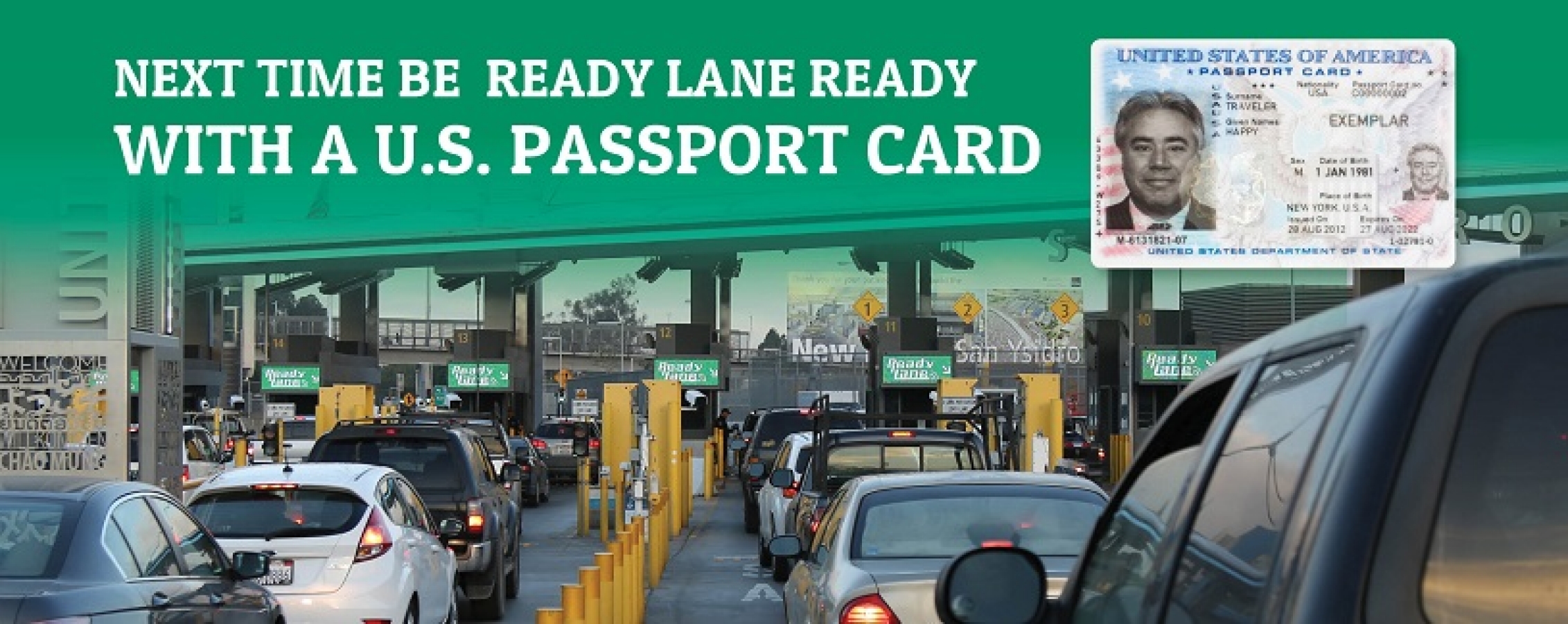
External Link
You are about to leave travel.state.gov for an external website that is not maintained by the U.S. Department of State.
Links to external websites are provided as a convenience and should not be construed as an endorsement by the U.S. Department of State of the views or products contained therein. If you wish to remain on travel.state.gov, click the "cancel" message.
You are about to visit:

Howmuchtoflythere

What documents do I need to travel to Mexico?
When planning a trip to Mexico, it’s essential to ensure you have all the necessary documents to enter the country. The documents required for travel to Mexico vary depending on your nationality and the purpose of your visit. Here’s a comprehensive guide to the documents you may need to travel to Mexico.
Documents to enter Mexico
- Valid passport : Ensure your passport is valid for at least six months beyond your intended stay in Mexico.
- Mexican Tourist Card (FMM) : Fill out the Forma Migratoria Múltiple (FMM) either online or upon arrival in Mexico.
- Visa (if required) : Check if your nationality requires a visa to enter Mexico and obtain it if necessary.
- Return ticket : Have a copy of your return ticket to show proof of your departure from Mexico.
- Proof of accommodation : Carry documentation confirming where you will be staying during your visit.
- Travel insurance : Consider purchasing travel insurance to cover any unexpected events during your trip.
- Contact information : Keep a list of emergency contacts and important phone numbers while in Mexico.
U.S. Citizens
U.S. citizens are required to present a valid passport to enter Mexico. However, there are some exceptions. For instance, U.S. citizens traveling by land or sea for less than 72 hours can present a government-issued photo ID, such as a driver’s license or a state-issued ID, along with proof of citizenship, like a birth certificate.
Canadian Citizens
Canadian citizens can enter Mexico with a valid passport or a government-issued photo ID, such as a driver’s license, along with proof of citizenship, like a birth certificate or a naturalization certificate.
We also recommend reading Medications Not Allowed in Mexico and What to Pack for Mexico
Mexican Citizens
Mexican citizens do not need a passport to enter Mexico, but they must present a valid national identity card (cedula de identidad) or a voter identification card (credential de elector).
Other Nationalities
If you’re a citizen of a country other than the U.S., Canada, or Mexico, you’ll need a valid passport to enter Mexico. Some countries may require additional documents, such as a visa or proof of sufficient funds for your stay.
Visa Requirements
In most cases, U.S. and Canadian citizens do not need a visa to enter Mexico for tourism purposes. However, if you’re planning to stay in Mexico for more than 180 days, you’ll need a visa. Mexican citizens, as well as citizens of some other countries, may also need a visa to enter Mexico.
Traveling with Minors
If you’re traveling with minors, you’ll need to present a notarized letter of consent from the child’s other parent or legal guardian if the child is not traveling with both parents.
Obtaining Documents
If you don’t already have the necessary documents, you can obtain them from the appropriate government agency in your country. For example, U.S. citizens can apply for a passport at a local passport office or a passport acceptance facility. Canadian citizens can apply for a passport at a Service Canada office. Mexican citizens can apply for a national identity card at a local immigration office.
Popular questions
Mexican Peso (MXN) is the currency accepted in Mexico
No, there is no Visa requirement for traveling to Mexico; however, a valid passport is necessary
When traveling to Mexico, it is advisable to stay in well-known tourist areas, avoid displaying valuables, be cautious of your surroundings, and use reputable transportation services
Mexico has a rich cultural heritage, including being the birthplace of chocolate, having the second-highest number of UNESCO World Heritage sites in the Americas, and being home to the world’s smallest volcano
Similar Posts

What food can I take into Mexico?
When traveling to Mexico, it is essential to be aware of the regulations regarding what food items you can bring into the country. Here is a comprehensive guide on what you can and cannot take with you: Permitted Food Items What Needs to Be Declared Prohibited Items Traveling with Pets Regulations on Donations Additional Information…

USA to Mexico flight time
Duration of a Flight The typical duration of flights between the United States and Mexico is about two hours and thirty-nine minutes. This is based on the average speed of a commercial airliner, which travels at a speed of 500 mph or 805 km/h (434 knots). Flight time is based on the straight line distance…

What to Pack for Mexico
What to take when traveling to Mexico When preparing for a trip to Mexico, it’s essential to pack wisely to ensure a comfortable and enjoyable experience. To help you plan and organize your packing, we’ve compiled a comprehensive list of essential items based on insights from various travel resources and experienced travelers. Clothing and Accessories…

What can you not bring to Mexico?
When traveling to Mexico, it’s important to be aware of the regulations regarding the items you can and cannot bring into the country. Mexico has strict rules to ensure the safety and well-being of its residents and visitors. Here’s a guide to help you understand what items you cannot bring to Mexico. What you can…

How much does a trip to Cancun cost
Cancun, with its pristine beaches and vibrant culture, is a sought-after vacation destination. However, the cost of a trip to Cancun can vary widely based on factors such as the duration of stay, the choice of accommodation, and the activities planned. Hotel Category Average Price per Night for a Week (USD) Average Price per Night…

Medications Not Allowed in Mexico
When traveling to Mexico, it’s important to be aware of the country’s regulations regarding medications. Certain medications that are commonly available in other countries, including the United States, may be prohibited in Mexico. It’s essential for travelers to understand these restrictions to avoid any legal issues or complications during their visit. Here’s a comprehensive guide…
You are using an outdated browser. Upgrade your browser today or install Google Chrome Frame to better experience this site.
Mexico Traveler View
Travel health notices, vaccines and medicines, non-vaccine-preventable diseases, stay healthy and safe.
- Packing List
After Your Trip

Be aware of current health issues in Mexico. Learn how to protect yourself.
Level 1 Practice Usual Precautions
- Updated Global Dengue August 14, 2024 Dengue is a year-round risk in many parts of the world, with outbreaks commonly occurring every 2–5 years. Travelers to risk areas should prevent mosquito bites. Destination List: Afghanistan, and Austral Islands (Tubuai and Rurutu), and Bora-Bora), Brazil, Burkina Faso, Cape Verde, Colombia, Costa Rica, Cuba, Ecuador, including the Galápagos Islands, El Salvador, French Guiana (France), French Polynesia, including the island groups of Society Islands (Tahiti, Ghana, Guatemala, Guyana, Honduras, Iran, Laos, Mali, Marquesas Islands (Hiva Oa and Ua Huka), Mauritius, Mexico, Moorea, Panama, Samoa, Singapore, Sri Lanka, Sudan, Uruguay
- Salmonella Newport in Mexico May 30, 2024 Some travelers who have spent time in Mexico have been infected with multidrug-resistant (MDR) Salmonella Newport.
- Rocky Mountain Spotted Fever in Mexico March 12, 2024 There have been reports of Rocky Mountain spotted fever (RMSF) in people traveling to the United States from Tecate, in the state of Baja California, Mexico.
⇧ Top
Check the vaccines and medicines list and visit your doctor at least a month before your trip to get vaccines or medicines you may need. If you or your doctor need help finding a location that provides certain vaccines or medicines, visit the Find a Clinic page.
Avoid contaminated water
Leptospirosis
How most people get sick (most common modes of transmission)
- Touching urine or other body fluids from an animal infected with leptospirosis
- Swimming or wading in urine-contaminated fresh water, or contact with urine-contaminated mud
- Drinking water or eating food contaminated with animal urine
- Avoid contaminated water and soil
- Avoid floodwater
Clinical Guidance
Avoid bug bites, chagas disease (american trypanosomiasis).
- Accidentally rub feces (poop) of the triatomine bug into the bug bite, other breaks in the skin, your eyes, or mouth
- From pregnant woman to her baby, contaminated blood products (transfusions), or contaminated food or drink.
- Avoid Bug Bites
Chagas disease
- Mosquito bite
Leishmaniasis
- Sand fly bite
- An infected pregnant woman can spread it to her unborn baby
Airborne & droplet
Avian/bird flu.
- Being around, touching, or working with infected poultry, such as visiting poultry farms or live-animal markets
- Avoid domestic and wild poultry
- Breathing in air or accidentally eating food contaminated with the urine, droppings, or saliva of infected rodents
- Bite from an infected rodent
- Less commonly, being around someone sick with hantavirus (only occurs with Andes virus)
- Avoid rodents and areas where they live
- Avoid sick people
Tuberculosis (TB)
- Breathe in TB bacteria that is in the air from an infected and contagious person coughing, speaking, or singing.
Learn actions you can take to stay healthy and safe on your trip. Vaccines cannot protect you from many diseases in Mexico, so your behaviors are important.
Eat and drink safely
Food and water standards around the world vary based on the destination. Standards may also differ within a country and risk may change depending on activity type (e.g., hiking versus business trip). You can learn more about safe food and drink choices when traveling by accessing the resources below.
- Choose Safe Food and Drinks When Traveling
- Water Treatment Options When Hiking, Camping or Traveling
- Global Water, Sanitation and Hygiene (WASH)
- Avoid Contaminated Water During Travel
You can also visit the Department of State Country Information Pages for additional information about food and water safety.
Prevent bug bites
Bugs (like mosquitoes, ticks, and fleas) can spread a number of diseases in Mexico. Many of these diseases cannot be prevented with a vaccine or medicine. You can reduce your risk by taking steps to prevent bug bites.
What can I do to prevent bug bites?
- Cover exposed skin by wearing long-sleeved shirts, long pants, and hats.
- Use an appropriate insect repellent (see below).
- Use permethrin-treated clothing and gear (such as boots, pants, socks, and tents). Do not use permethrin directly on skin.
- Stay and sleep in air-conditioned or screened rooms.
- Use a bed net if the area where you are sleeping is exposed to the outdoors.
What type of insect repellent should I use?
- FOR PROTECTION AGAINST TICKS AND MOSQUITOES: Use a repellent that contains 20% or more DEET for protection that lasts up to several hours.
- Picaridin (also known as KBR 3023, Bayrepel, and icaridin)
- Oil of lemon eucalyptus (OLE) or para-menthane-diol (PMD)
- 2-undecanone
- Always use insect repellent as directed.
What should I do if I am bitten by bugs?
- Avoid scratching bug bites, and apply hydrocortisone cream or calamine lotion to reduce the itching.
- Check your entire body for ticks after outdoor activity. Be sure to remove ticks properly.
What can I do to avoid bed bugs?
Although bed bugs do not carry disease, they are an annoyance. See our information page about avoiding bug bites for some easy tips to avoid them. For more information on bed bugs, see Bed Bugs .
For more detailed information on avoiding bug bites, see Avoid Bug Bites .
Some diseases in Mexico—such as dengue, Zika, leishmaniasis, and Chagas disease—are spread by bugs and cannot be prevented with a vaccine. Follow the insect avoidance measures described above to prevent these and other illnesses.
Stay safe outdoors
If your travel plans in Mexico include outdoor activities, take these steps to stay safe and healthy during your trip.
- Stay alert to changing weather conditions and adjust your plans if conditions become unsafe.
- Prepare for activities by wearing the right clothes and packing protective items, such as bug spray, sunscreen, and a basic first aid kit.
- Consider learning basic first aid and CPR before travel. Bring a travel health kit with items appropriate for your activities.
- If you are outside for many hours in heat, eat salty snacks and drink water to stay hydrated and replace salt lost through sweating.
- Protect yourself from UV radiation : use sunscreen with an SPF of at least 15, wear protective clothing, and seek shade during the hottest time of day (10 a.m.–4 p.m.).
- Be especially careful during summer months and at high elevation. Because sunlight reflects off snow, sand, and water, sun exposure may be increased during activities like skiing, swimming, and sailing.
- Very cold temperatures can be dangerous. Dress in layers and cover heads, hands, and feet properly if you are visiting a cold location.
Stay safe around water
- Swim only in designated swimming areas. Obey lifeguards and warning flags on beaches.
- Practice safe boating—follow all boating safety laws, do not drink alcohol if driving a boat, and always wear a life jacket.
- Do not dive into shallow water.
- Do not swim in freshwater in developing areas or where sanitation is poor.
- Avoid swallowing water when swimming. Untreated water can carry germs that make you sick.
- To prevent infections, wear shoes on beaches where there may be animal waste.
Leptospirosis, a bacterial infection that can be spread in fresh water, is found in Mexico. Avoid swimming in fresh, unchlorinated water, such as lakes, ponds, or rivers.
Keep away from animals
Most animals avoid people, but they may attack if they feel threatened, are protecting their young or territory, or if they are injured or ill. Animal bites and scratches can lead to serious diseases such as rabies.
Follow these tips to protect yourself:
- Do not touch or feed any animals you do not know.
- Do not allow animals to lick open wounds, and do not get animal saliva in your eyes or mouth.
- Avoid rodents and their urine and feces.
- Traveling pets should be supervised closely and not allowed to come in contact with local animals.
- If you wake in a room with a bat, seek medical care immediately. Bat bites may be hard to see.
All animals can pose a threat, but be extra careful around dogs, bats, monkeys, sea animals such as jellyfish, and snakes. If you are bitten or scratched by an animal, immediately:
- Wash the wound with soap and clean water.
- Go to a doctor right away.
- Tell your doctor about your injury when you get back to the United States.
Consider buying medical evacuation insurance. Rabies is a deadly disease that must be treated quickly, and treatment may not be available in some countries.
Reduce your exposure to germs
Follow these tips to avoid getting sick or spreading illness to others while traveling:
- Wash your hands often, especially before eating.
- If soap and water aren’t available, clean hands with hand sanitizer (containing at least 60% alcohol).
- Don’t touch your eyes, nose, or mouth. If you need to touch your face, make sure your hands are clean.
- Cover your mouth and nose with a tissue or your sleeve (not your hands) when coughing or sneezing.
- Try to avoid contact with people who are sick.
- If you are sick, stay home or in your hotel room, unless you need medical care.
Avoid sharing body fluids
Diseases can be spread through body fluids, such as saliva, blood, vomit, and semen.
Protect yourself:
- Use latex condoms correctly.
- Do not inject drugs.
- Limit alcohol consumption. People take more risks when intoxicated.
- Do not share needles or any devices that can break the skin. That includes needles for tattoos, piercings, and acupuncture.
- If you receive medical or dental care, make sure the equipment is disinfected or sanitized.
Know how to get medical care while traveling
Plan for how you will get health care during your trip, should the need arise:
- Carry a list of local doctors and hospitals at your destination.
- Review your health insurance plan to determine what medical services it would cover during your trip. Consider purchasing travel health and medical evacuation insurance.
- Carry a card that identifies, in the local language, your blood type, chronic conditions or serious allergies, and the generic names of any medications you take.
- Some prescription drugs may be illegal in other countries. Call Mexico’s embassy to verify that all of your prescription(s) are legal to bring with you.
- Bring all the medicines (including over-the-counter medicines) you think you might need during your trip, including extra in case of travel delays. Ask your doctor to help you get prescriptions filled early if you need to.
Many foreign hospitals and clinics are accredited by the Joint Commission International. A list of accredited facilities is available at their website ( www.jointcommissioninternational.org ).
In some countries, medicine (prescription and over-the-counter) may be substandard or counterfeit. Bring the medicines you will need from the United States to avoid having to buy them at your destination.
Malaria is a risk in some parts of Mexico. If you are going to a risk area, fill your malaria prescription before you leave, and take enough with you for the entire length of your trip. Follow your doctor’s instructions for taking the pills; some need to be started before you leave.
Select safe transportation
Motor vehicle crashes are the #1 killer of healthy US citizens in foreign countries.
In many places cars, buses, large trucks, rickshaws, bikes, people on foot, and even animals share the same lanes of traffic, increasing the risk for crashes.
Be smart when you are traveling on foot.
- Use sidewalks and marked crosswalks.
- Pay attention to the traffic around you, especially in crowded areas.
- Remember, people on foot do not always have the right of way in other countries.
Riding/Driving
Choose a safe vehicle.
- Choose official taxis or public transportation, such as trains and buses.
- Ride only in cars that have seatbelts.
- Avoid overcrowded, overloaded, top-heavy buses and minivans.
- Avoid riding on motorcycles or motorbikes, especially motorbike taxis. (Many crashes are caused by inexperienced motorbike drivers.)
- Choose newer vehicles—they may have more safety features, such as airbags, and be more reliable.
- Choose larger vehicles, which may provide more protection in crashes.
Think about the driver.
- Do not drive after drinking alcohol or ride with someone who has been drinking.
- Consider hiring a licensed, trained driver familiar with the area.
- Arrange payment before departing.
Follow basic safety tips.
- Wear a seatbelt at all times.
- Sit in the back seat of cars and taxis.
- When on motorbikes or bicycles, always wear a helmet. (Bring a helmet from home, if needed.)
- Avoid driving at night; street lighting in certain parts of Mexico may be poor.
- Do not use a cell phone or text while driving (illegal in many countries).
- Travel during daylight hours only, especially in rural areas.
- If you choose to drive a vehicle in Mexico, learn the local traffic laws and have the proper paperwork.
- Get any driving permits and insurance you may need. Get an International Driving Permit (IDP). Carry the IDP and a US-issued driver's license at all times.
- Check with your auto insurance policy's international coverage, and get more coverage if needed. Make sure you have liability insurance.
- Avoid using local, unscheduled aircraft.
- If possible, fly on larger planes (more than 30 seats); larger airplanes are more likely to have regular safety inspections.
- Try to schedule flights during daylight hours and in good weather.
Medical Evacuation Insurance
If you are seriously injured, emergency care may not be available or may not meet US standards. Trauma care centers are uncommon outside urban areas. Having medical evacuation insurance can be helpful for these reasons.
Helpful Resources
Road Safety Overseas (Information from the US Department of State): Includes tips on driving in other countries, International Driving Permits, auto insurance, and other resources.
The Association for International Road Travel has country-specific Road Travel Reports available for most countries for a minimal fee.
For information traffic safety and road conditions in Mexico, see Travel and Transportation on US Department of State's country-specific information for Mexico .
Maintain personal security
Use the same common sense traveling overseas that you would at home, and always stay alert and aware of your surroundings.
Before you leave
- Research your destination(s), including local laws, customs, and culture.
- Monitor travel advisories and alerts and read travel tips from the US Department of State.
- Enroll in the Smart Traveler Enrollment Program (STEP) .
- Leave a copy of your itinerary, contact information, credit cards, and passport with someone at home.
- Pack as light as possible, and leave at home any item you could not replace.
While at your destination(s)
- Carry contact information for the nearest US embassy or consulate .
- Carry a photocopy of your passport and entry stamp; leave the actual passport securely in your hotel.
- Follow all local laws and social customs.
- Do not wear expensive clothing or jewelry.
- Always keep hotel doors locked, and store valuables in secure areas.
- If possible, choose hotel rooms between the 2nd and 6th floors.
To call for emergency services while in Mexico, dial 066, 060, or 080. Write these numbers down to carry with you during your trip.
Learn as much as you can about Mexico before you travel there. A good place to start is the country-specific information on Mexico from the US Department of State.
Americans in Mexico have been arrested for purchasing souvenirs that were, or looked like, antiques and that local customs authorities believed were national treasures. Familiarize yourself with any local regulations for antiques and follow these tips:
- When you are considering purchasing an authentic antique or a reproduction, ask if you are allowed to export these items before you purchase them.
- If you buy a reproduction, document on the customs form that it is a reproduction.
- If you buy an authentic antique, obtain the necessary export permit (often from the national museum).
Healthy Travel Packing List
Use the Healthy Travel Packing List for Mexico for a list of health-related items to consider packing for your trip. Talk to your doctor about which items are most important for you.
Why does CDC recommend packing these health-related items?
It’s best to be prepared to prevent and treat common illnesses and injuries. Some supplies and medicines may be difficult to find at your destination, may have different names, or may have different ingredients than what you normally use.
If you are not feeling well after your trip, you may need to see a doctor. If you need help finding a travel medicine specialist, see Find a Clinic . Be sure to tell your doctor about your travel, including where you went and what you did on your trip. Also tell your doctor if you were bitten or scratched by an animal while traveling.
If your doctor prescribed antimalarial medicine for your trip, keep taking the rest of your pills after you return home. If you stop taking your medicine too soon, you could still get sick.
Malaria is always a serious disease and may be a deadly illness. If you become ill with a fever either while traveling in a malaria-risk area or after you return home (for up to 1 year), you should seek immediate medical attention and should tell the doctor about your travel history.
For more information on what to do if you are sick after your trip, see Getting Sick after Travel .
Map Disclaimer - The boundaries and names shown and the designations used on maps do not imply the expression of any opinion whatsoever on the part of the Centers for Disease Control and Prevention concerning the legal status of any country, territory, city or area or of its authorities, or concerning the delimitation of its frontiers or boundaries. Approximate border lines for which there may not yet be full agreement are generally marked.
Other Destinations
If you need help finding travel information:
Message & data rates may apply. CDC Privacy Policy
File Formats Help:
- Adobe PDF file
- Microsoft PowerPoint file
- Microsoft Word file
- Microsoft Excel file
- Audio/Video file
- Apple Quicktime file
- RealPlayer file
- Zip Archive file
Cookies on GOV.UK
We use some essential cookies to make this website work.
We’d like to set additional cookies to understand how you use GOV.UK, remember your settings and improve government services.
We also use cookies set by other sites to help us deliver content from their services.
You have accepted additional cookies. You can change your cookie settings at any time.
You have rejected additional cookies. You can change your cookie settings at any time.
Entry requirements
This information is for people travelling on a full ‘British citizen’ passport from the UK. It is based on the UK government’s understanding of the current rules for the most common types of travel.
The authorities in Mexico set and enforce entry rules. If you’re not sure how these requirements apply to you, contact the Mexican Embassy in the UK .
COVID-19 rules
There are no COVID-19 testing or vaccination requirements for travellers entering Mexico.
Passport validity requirements
To enter Mexico, your passport must be valid for the duration of your stay.
The Mexican Embassy in the UK recommends passports be valid for at least 180 days because this is the longest you can stay in Mexico as a tourist.
If you’re travelling through another country on your way to or from Mexico, check the entry requirements for that country. Many countries will only allow entry if you have at least 6 months validity remaining on your passport.
Visa requirements
If you’re visiting Mexico as a tourist, you do not need a visa. You’ll get a stamp in your passport with the number of days you are allowed to stay.
British nationals entering Mexico by land must fill in an immigration form online .
Applying for a visa
The Mexican Embassy has information on applying for a visa in the UK .
See information on applying for a visa in Mexico (in Spanish).
Travelling through the USA
If you are travelling or transiting through the USA to or from Mexico, see entry requirements in USA travel advice or contact the US Embassy in London . If you do not have an Electronic System for Travel Authorisation (ESTA) visa waiver or the correct visa, you will not be allowed to travel to the USA.
Employment, voluntary work, research and eco activities
Tourists cannot do any type of voluntary or paid work or activity, including human rights work. To work or volunteer, you must get the correct visa from the Mexican Embassy before you travel.
You may need a visa for some adventure or ecotourism activities like caving, potholing or entomology, especially if they involve any scientific or technological research. The Mexican authorities may define scientific or technological research activities far more broadly than other countries. If in doubt, ask the Mexican Embassy in UK well before you travel and ask for written confirmation if necessary.
Airport e-gates for tourists
If you are a tourist aged 18 or over, you can use e-gates in some of the main international airports in Mexico. You must show the printed e-gate ticket when you leave the country, so be sure to collect it.
You can download digital proof of entry and how long you are allowed to stay in Mexico from Portal de Servicios del INM (in Spanish) within the first 60 days of your visit.
Checks at border control
At Mexican border control, you may need to:
- show a return or onward ticket
- show proof of your accommodation, for example, a hotel booking confirmation
- prove that you have enough money for your stay
If you’re staying in someone’s home, immigration officials may also ask for a ‘letter of invitation’ from the person you’re visiting. This should include as much information as possible, including the host and travellers’:
- contact details
- address while in Mexico
- reason for visit
Make sure you get your passport stamped on entry and exit.
If you’re entering Mexico from the USA, and there is no immigration officer to stamp your passport, find the nearest immigration office before continuing. Immigration offices are usually near the border, and customs officials should be able to direct you. It is often more complicated to correct immigration issues once you leave the border area.
Travelling with children
If you are travelling with a child, you may be asked for:
- evidence of your relationship with them – for example, a birth or adoption certificate, divorce or marriage certificates, or a parental responsibility order
- the reason you are travelling with them
Children with dual nationality
Children with dual nationality of Mexico who are travelling without a parent or legal guardian must apply for a permit to leave the country.
Vaccine requirements
For details about medical entry requirements and recommended vaccinations, see TravelHealthPro’s Mexico guide .
Customs rules
There are strict rules about goods you can bring into and take out of Mexico . You must declare anything that may be prohibited or subject to tax or duty.
Check whether you will need to declare anything to customs officials. If you have goods to declare, you must submit a customs form online before travelling to Mexico. If you do not declare goods, customs officials may seize them and you could get a fine.
Entry tax for the state of Quintana Roo
You must pay an entry tax to visit the state of Quintana Roo – you can pay the entry tax online before or during your stay. You can get help paying online at Cancun Airport. You must show proof of payment at the airport before leaving.
Leaving Mexico
To leave Mexico, you must show your passport with the entry stamp showing how many days you were allowed to stay.
If you lose your passport, you must pay a fee to replace the entry stamp. The fee is about 700 Mexican pesos, to be paid at the immigration office by card or in a bank with cash. Migration officers do not accept cash. You can replace the stamp at the immigration office at any international airport in Mexico or start the entry stamp replacement process online . Updated fees should be displayed at the immigration offices.
Fake immigration officers can operate in international airports. Always refuse offers of help and head directly to the immigration office.
Departure tax
You may need to pay a departure tax when leaving Mexico by air or land. The cost can vary, and some airports or border crossings only accept cash. Most airlines include the cost within the ticket price. If in doubt, check with your airline or tour operator.
Related content
Is this page useful.
- Yes this page is useful
- No this page is not useful
Help us improve GOV.UK
Don’t include personal or financial information like your National Insurance number or credit card details.
To help us improve GOV.UK, we’d like to know more about your visit today. Please fill in this survey (opens in a new tab) .

Traveling To Mexico By Car: Your Complete Guide

About the author
Alex Gomez, the founder of Mexico Travel Buddy, combines his firsthand, on-the-ground experiences in Mexico with a personal connection to the country, fostered through his Mexican wife and numerous explorations. More info
If you’ve thought about taking a road trip to one of the greatest countries in the world, you may be wondering what exactly is required to travel to Mexico by vehicle.
This article covers everything you need to know about traveling to Mexico by car. Jump to whichever section you find most relevant using the following table of contents.
When you’re ready, you will also need to purchase a Mexican car insurance policy – check out my comprehensive guide on that topic.
Required Documents To Travel To Mexico By Car
Driving to Mexico from the U.S. is quite simple. However, you need to ensure you have a few things before crossing the border by land. Make sure you have these essentials, or you won’t be crossing the border anytime soon.
- Valid Passport Card or Book (passport card is more convenient)
Entry Permit (FMM)
- Mexican Vehicle Insurance (if your current policy doesn’t cover you in Mexico)
Valid Proof Of Vehicle Registration
- Temporary Vehicle Importation Permit (purchase online at Banjercito.com or at the border)
Crossing The Border Into Mexico By Car
Upon arrival at the U.S. – Mexico border, you will need to choose the appropriate lane for your situation. If you have more than $75 worth of merchandise, but no more than $1,000 per person, then you must proceed to the “Declaration Lane.” Here you will fill out a declaration form regarding the merchandise you are bringing across the border.

If you have nothing to declare besides your personal items, choose the “Nothing To Declare” lane.
Regardless of which lane you choose, if you get the green light, you are good to proceed. However, if you get a red light, you must head to the secondary inspection area.
See also: Mexican Car Insurance: Everything You Need To Know
Here, CBP will inspect your vehicle and likely ask a few more questions about your travel plans. No need to panic here, they are just doing their job, and you will be on your way within a few minutes as long as you have nothing to hide.
If CBP finds something in your vehicle that should have been declared but wasn’t, you risk a fine or even jail time. So please don’t risk it.
Do You Need A Passport To Go To Mexico By Car
U.S. citizens must present a valid passport book or card and their Entry Permit (FMM) upon entry into Mexico.
A passport card is more convenient due to its RFID chip technology. If you have one of these cards, you can drive through a designated Ready Lane at the border and save some time (find out more info here ).
How To Use The Ready Lane
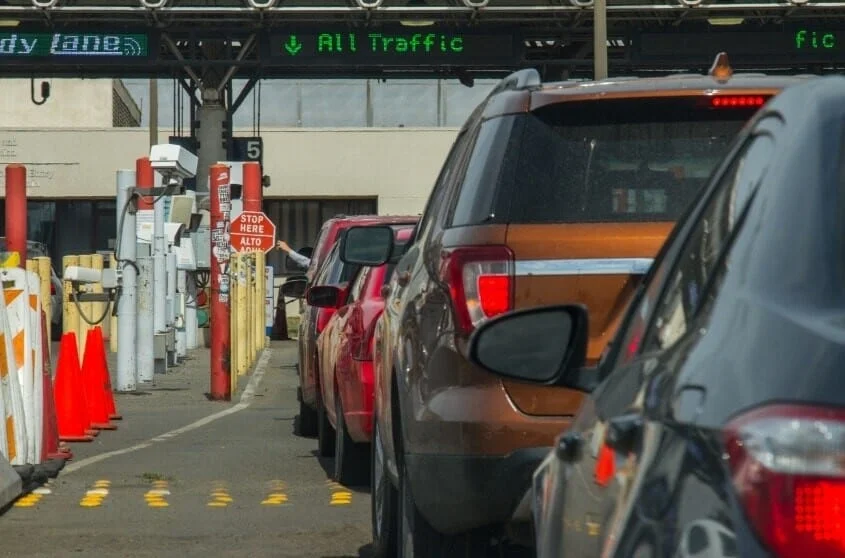
Once you have located the Ready Lane, get out your passport card and get ready to scan. When you pull up, display each card to the “Point Cards Here” sign on the in-lane reader.
Once you are finished, proceed forward as directed by a CBP officer and wait for further instructions.
See also: 13 Safest Cities In Mexico Worth Visiting – Insider Insights
In addition to your passport, you will need your entry permit, otherwise known as Forma Migratoria Multiple. Although they may not check for this form at the time of your border crossing, it is still a legal requirement to have this form on you when visiting Mexico as a foreigner.
You can get your Entry Permit at the Mexican Immigration office at the border, usually within minutes, and it only requires a valid passport to receive. If you prefer being ready ahead of time, you may fill a form out online instead .
You must ensure the vehicle you’re driving to Mexico with has a valid registration. If you are caught in Mexico without registration or even expired tags, you risk having your vehicle confiscated by Mexican authorities . Furthermore, you may end up with additional fines and potentially incarceration.
Why even risk the hassle of any of these potential outcomes? Confirm your registration is good, and you will be good. Simple.
When Is A Temporary Vehicle Importation Permit Required
A temporary vehicle permit is not required if you are traveling within the “Free Zone” (no further than 25 miles past the border or 60 miles in Sonora) or when driving in the Baja Peninsula . A TIP is good for up to 6 months on a foreign vehicle for private use.
If you plan on traveling outside of the Free Zone, a Temporary Vehicle Permit is required .
See also: What You Need To Legally Fish In Mexico: A Complete Guide
Where To Get A Temporary Vehicle Importation Permit
You may request a temporary vehicle permit online or in person at Banjercito . When requesting your permit online, I recommend you do this 7 to 14 days in advance of your planned trip.
If you prefer to get your temporary vehicle permit in person, you may do so at a Banjercito office at the Mexico border, or you can schedule an appointment at certain Mexican Consulates in the U.S. Click HERE to schedule an appointment at your nearest consulate.
Documents Required To Receive a Temporary Vehicle Importation Permit
If you need a TIP, make sure you have the required documents to prove legal ownership of the vehicle being temporarily imported.
Mexicans with legal residency outside of Mexico must have the following documents to receive their Temporary Vehicle Permit:
- Permanent Resident Card
- Passport (Not Mexican)
- Passport Card
Requirements For A Financed Vehicle To Receive Your TIP
If your vehicle is still financed and you do not have the title in hand, you will need to request a letter of permission from your lender. Generally, the lender will need a copy of your Mexican insurance policy for your vehicle. Your policy will need to show coverage for the entire time you plan on being in Mexico with your vehicle.
Note that if you owe more on your vehicle than it is actually worth, your lender may require a more expensive insurance policy to be purchased in order to cover the total loan amount.
Cost Of A Temporary Vehicle Importation Permit
Do you need mexico car insurance to drive in mexico.
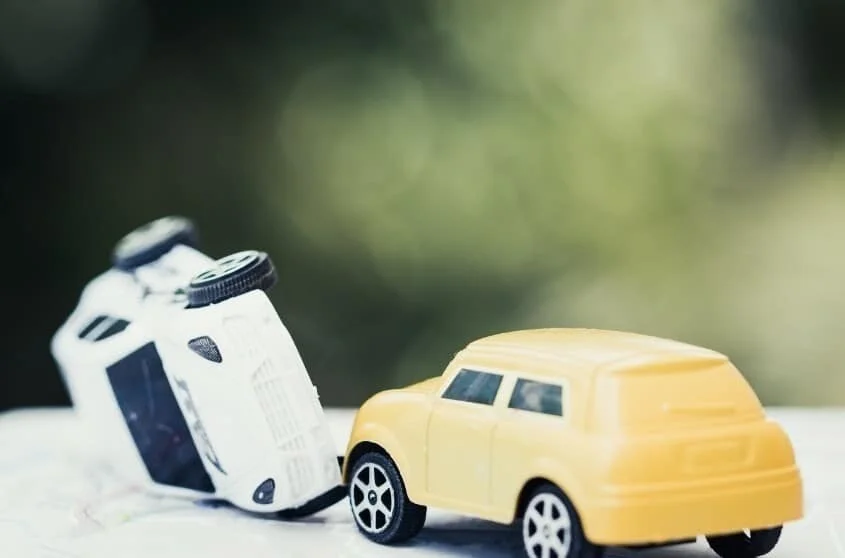
Only third-party liability (TPL) insurance is required by law in Mexico when operating any vehicle on a federal roadway; any other insurance is optional. If you are pulled over without proper insurance coverage or involved in an accident, you may be fined up to $500,000 ! Not only that, but you may be thrown in jail.
Most U.S. insurance policies will not cover you or your vehicle while in Mexico, so check with your current insurance provider.
Where To Buy Mexico Vehicle Insurance
You may purchase a Mexican insurance policy at the border or conveniently online at BajaBound.com . I highly recommend you purchase your Mexico insurance policy before leaving on your trip so there is no hassle at the border and you are stress-free.
SO PLEASE , get a dang insurance policy so you are covered in Mexico. I don’t care where you get your policy. Ensure you have a policy to avoid any potential fines or imprisonment. It’s not something worth risking, at least not in my opinion.
You will need to purchase a Mexican insurance policy for the time you will be traveling in Mexico. I don’t want you to worry; getting a Mexican insurance policy is generally quick and easy. You can even ask your current insurer if they have a policy you can purchase for use in Mexico.
Otherwise, I would personally get insurance through BajaBound Mexican Insurance . They are the easiest way to get Mexican auto insurance, and you can have a quote supplied instantly after submitting the required information.
They have been in business for over 20 years and are also rated A+ by the Better Business Bureau the last time I checked. As well they offer 24/7 customer service and have some of the best rates you will find, even for the budget traveler. I took these screenshots to show you how simple getting insurance on BajaBound is.

If you don’t get your insurance through BajaBound, at least check out their site ; they also have some excellent information regarding traveling to Mexico.
Don’t forget to also visit my article on Mexican Car Insurance for more in-depth information.
Driving A Rental Vehicle To Mexico
If you plan on taking a rental vehicle to Mexico, you will first need to find a rental company that allows their vehicles to travel out of the country to Mexico. Also, you will need the rental company to provide a letter of permission stating you can drive the vehicle to Mexico.
Only a few rental car companies will even consider allowing you to take their vehicle out of the country and into Mexico. Budget rental car company will allow you to take their vehicle into Mexico but you must sign up for a corporate account; so if you’re not traveling for work, good luck.
Enterprise , however, will let anyone drive their vehicles to Mexico. The only catch is that only certain branches will offer this service. Contact whichever branch you are renting from to confirm they allow travel to Mexico.
If you can’t find a branch locally that offers this, you may have better luck contacting a branch closer to the U.S. – Mexico border. Moreover, you will have to purchase Mexican auto insurance through them as part of the fee.
Is There A Fee To Enter Mexico By Land
The fee to enter Mexico by land or air is approximately $25.00 . When you purchase your Entry Permit (FMM), this is the entry form you are paying for that allows you entry into Mexico and is valid for up to 180 days once stamped. If you are staying in Mexico for 7 days or less, there is no fee.
Is It Safe To Travel To Mexico By Car
Generally, traveling to Mexico by car is considered safe. However, I recommend you avoid driving at night if you can to avoid potential crime , animal crossings, and large potholes in the roadway.
When driving in Mexico, it’s important you keep some pesos on you for toll fees. Also, carry some extra pesos if you need to stop somewhere to purchase anything. If you stop in a smaller town, they may have out-of-date ATMs or even no ATMs, so it’s best to be prepared and have some extra cash on you.
Prohibited And Restricted Items Not To Bring Back To The U.S.
The items that CBP prevents you from bringing back into the U.S. may injure community health, public safety, American workers, children, domestic plant and animal life or those that would defeat our national interests.
If an item is prohibited , it is forbidden by law to enter the U.S. with them. Some examples of prohibited items are dangerous toys, bush meat, or a vehicle without proper safety standards.
If an item is restricted , you need proper licenses or permits from a federal agency before the item is allowed into the U.S. Some examples of restricted items would be certain fruits and vegetables, animal by-products, and firearms.
Driving to Mexico can be quite an experience, especially if it is your first time. Being prepared and knowing what to expect will save you a lot of time and hassle when you get to the border.
It’s not as bad as you may think, though. Over 19 million people travel to Mexico by land every single year. So there is no reason to feel alone or even crazy about driving to Mexico because it’s very common.

Alex Gomez, the founder of Mexico Travel Buddy, combines his firsthand, on-the-ground experiences in Mexico with a personal connection to the country, fostered through his Mexican wife and numerous explorations. As a professional writer and avid travel enthusiast, his favorite destination remains anywhere within Mexico's diverse landscapes. His extensive travels have equipped him with a treasure trove of tips, tricks, and insights, which he enthusiastically shares with his audience. Alex's stories and photos on the website not only showcase his love for Mexico but also offer readers a deeply authentic and engaging perspective.
Read more by Alex Gomez
Leave a Comment Cancel reply
Welcome to mexico travel buddy.
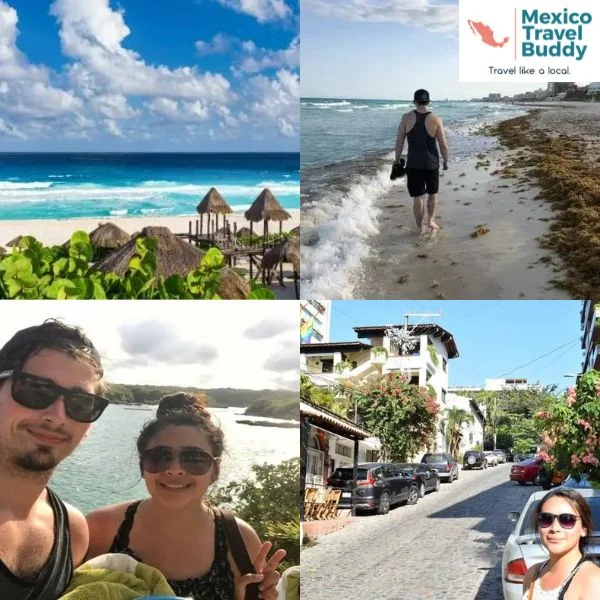
We are excited to help you make the most out of your travels to Mexico, in a safe and joyful manner!
We share our personal experiences and expert advice so you can travel Mexico like a local.
Find out more about our journey and our love for Mexico.
Follow us on our socials!
Looking for something or somewhere specific? We might just have it!
Travel Like A Local Where's Your Next Stop?
Recent Posts

San Ignacio Mexico Travel Guide
March 30, 2024

Everything You Need to Know About Punta Baja: The Sleepy Seaside Camp of Your Dreams

Pescadero Mexico Travel Guide

Mulege Baja California Travel Guide

An official website of the United States government
Here’s how you know

Official websites use .gov A .gov website belongs to an official government organization in the United States.
Secure .gov websites use HTTPS A lock ( Lock A locked padlock ) or https:// means you’ve safely connected to the .gov website. Share sensitive information only on official, secure websites.

- Documents Library
Final EA: Consolidated Towers and Surveillance Equipment on BLM Lands in NM
This Environmental Assessment analyzes the potential environmental consequences of deploying and operating 14 Integrated Surveillance Tower (IST) - Consolidated Tower and Surveillance Equipment (CTSE) at site administered by the Bureau of Land Management (BLM) Las Cruces District Office (LCDO) within the U.S. Border Patrol (USBP) El Paso Sector (EPT) Area of Responsibility (AOR). The CTSEs would provide long-range, persistent surveillance, enabling USBP personnel to detect, track, identify, and classify illegal entries through a series of integrated sensors and tower-based surveillance equipment. The proposed CTSE program represents a technology solution for the distinct terrain within the EPT AOR.
CBP Publication Number

COMMENTS
Call us in Washington, D.C. at 1-888-407-4747 (toll-free in the United States and Canada) or 1-202-501-4444 (from all other countries) from 8:00 a.m. to 8:00 p.m., Eastern Standard Time, Monday through Friday (except U.S. federal holidays). See the State Department's travel website for the Worldwide Caution and Travel Advisories.
The documents you need to travel to Mexico by car or boat include: A passport or. A passport card. Trusted Traveler cards (SENTRI or FAST) State-issued Enhanced driver's license (when available) Enhanced Tribal Cards (when available) U.S. Military ID with military travel orders. U.S. Merchant Mariner credential when traveling in conjunction ...
Arrivals to Mexico by air. If you are visiting Mexico and arriving by airplane, you must carry a current passport. Note that Passport Cards are not valid for air travel. We also recommend that your passport is valid for at least six months from the date of your arrival in Mexico. If your passport is expired the airlines will not allow you to ...
1. A valid passport or travel document. There is no need for a minimum period of validity of the passport (for example 6 months); but this document must be valid during the length of your stay in Mexico. 2. A properly completed Multiple Digital Migration Form (FMMd). This form will be provided to you by the airline or at the port of entry.
The following items are considered valid identification documents for traveling to Mexico: A U.S. passport book (required for all international air travel to Mexico) A U.S. passport card. An enhanced driver's license (EDL) A trusted traveler program card (NEXUS card SENTRI card, FAST card, or Global Entry card)
Colombia 🇨🇴. Colombians & residents. Foreigners. Documents required to enter Colombia: Valid passport (minimum validity of 90 days) Residency (if applicable) Check-Mig form. You must complete the online form 48 hours and 1 hour before your flight and present the confirmation email to the customs officer.
If you hold a passport issued by one of the many countries on Mexico's " no visa required " list,* you don't need to apply for a visa to visit Mexico. You can, instead, complete a Visitor's Permit, also known as a FMM, at your port of entry. There is a ~US$25 fee for the permit, which is usually included in your airfare's "fees ...
Entry to Mexico: Essential Information for All Travelers. Regardless of whether you come to Mexico for leisure, for business or to take up residency here, take note of the following: Required documentation. For a summary of the documentation required to enter Mexico, see Documents required for travel and entry to Mexico. Minors traveling to ...
These documents are acceptable travel documents for all United States citizens. Passport card: Issued by the U.S. Department of State, this passport substitute is credit-card sized and valid for entry into Mexico by land or sea. The passport card is not accepted for air travel. This passport card can also be used for land and sea travel to ...
An electronic travel permit (officially called Sistema de Autorización Electrónica or SAE) is the easiest and quickest way to get permission to enter Mexico.To complete a SAE application, only the above documents are required and can be uploaded in digital format from anywhere in the world thanks to the online system.
Early in your travel planning, you should make sure you have all the necessary documents to travel to Mexico. Passports can take a few months to process so make sure you apply far enough in advance. You probably won't need to apply in advance for a visa: when you enter the country you will be given a tourist card. Passports and Travel Documents.
The U.S. government introduced the passport card as a convenient and cheaper alternative to the traditional passport book; it is good for land and sea travel to Mexico, Canada, and the Caribbean. The passport card is wallet-size (much like a driver's license) and includes information about its owner, including full name, nationality, place of birth, gender, dates of issue and expiration, a ...
Key Takeaways: To travel to Mexico, you'll need a valid passport or passport card, a tourist card, and possibly a visa or residency permit.; It's recommended to have travel insurance and necessary driving documents if planning to drive in Mexico. Minors traveling without both parents should have a notarized letter of permission, and carrying copies of important documents is advisable.
It's an entry requirement for all foreign visitors, including Americans. It's mandatory if you plan to travel more than 20 kilometers into Mexican territory and stay more than 72 hours. A Mexican tourist card for United States citizens is a single-entry document. It becomes invalid once you leave Mexico.
Find continuously updated travel restrictions for Mexico such as border, vaccination, COVID-19 testing, and quarantine requirements.
U.S. citizens must present a valid U.S. passport book or card, and an entry permit issued by Instituto Nacional de Migración. Enter Mexico with valid proof of automobile registration, even if remaining in the border zone. Entering Mexico with an expired U.S. vehicle registration may lead to the confiscation of the auto by Mexican authorities.
Documents You Will Need. Carry - do not pack - all travel documents. All U.S. citizens need U.S. passport books if re-entering by air. Land and sea border crossings accept additional travel documents, such as U.S. Passport cards and Trusted Traveler cards. Child travelers have additional options - see the Traveling with Children section.
The documents required for travel to Mexico vary depending on your nationality and the purpose of your visit. Here's a comprehensive guide to the documents you may need to travel to Mexico. Documents to enter Mexico. Valid passport: Ensure your passport is valid for at least six months beyond your intended stay in Mexico.
Report drug and alien smuggling. Call (956) 542-5811 in the U.S., 001800-0105237 from Mexico. Prohibited/Permissible Items. All articles acquired in Mexico must be declared. $800 exemption for gifts and personal articles, including one liter of alcoholic beverages per person over 21 every 30 days. Cuban cigars are prohibited.
Foreign citizens traveling to Mexico are issued an Official Entry Immigration Form (FMM) also known as Tourist Card. The online registration process is FREE, very convenient, straightforward, and to complete the process all you need is your passport and travel information. THE TOURIST CARD IS PER PERSON INCLUDING CHILDREN AND DIPLOMATIC PERSONNEL.
For information traffic safety and road conditions in Mexico, see Travel and Transportation on US Department of State's country-specific information for Mexico. Hide. ... document on the customs form that it is a reproduction. If you buy an authentic antique, obtain the necessary export permit (often from the national museum). Hide.
FCDO travel advice for Mexico. Includes safety and security, insurance, entry requirements and legal differences.
Required Documents To Travel To Mexico By Car. Driving to Mexico from the U.S. is quite simple. However, you need to ensure you have a few things before crossing the border by land. Make sure you have these essentials, or you won't be crossing the border anytime soon. ... Alex Gomez, the founder of Mexico Travel Buddy, combines his firsthand ...
This Environmental Assessment analyzes the potential environmental consequences of deploying and operating 14 Integrated Surveillance Tower (IST) - Consolidated Tower and Surveillance Equipment (CTSE) at site administered by the Bureau of Land Management (BLM) Las Cruces District Office (LCDO) within the U.S. Border Patrol (USBP) El Paso Sector (EPT) Area of Responsibility (AOR).